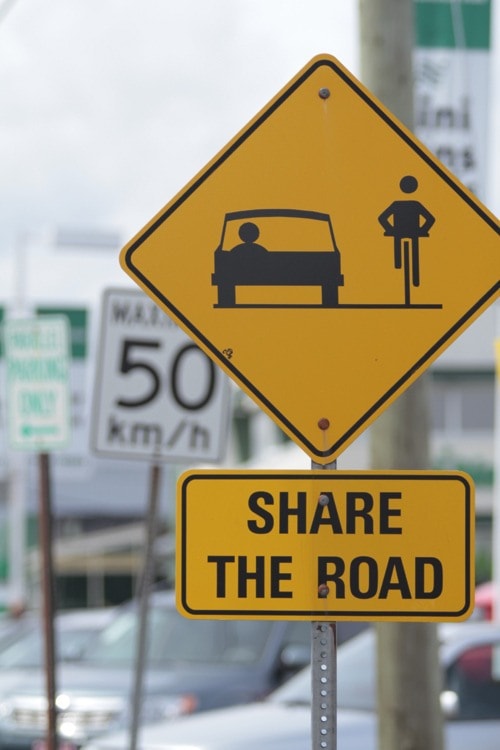Not following the rules of the road in a car can get you a ticket and a scolding from a police officer. Disregarding road rules on a bike can get you killed.
In B.C. cyclists must follow the same road regulations as any motor vehicle when riding in traffic. It’s the law, but it’s also common sense when one considers a rider on a 11-kilogram bike is no match for a 1,100 kg vehicle.
ICBC statistics show about 1,400 injuries arise from 1,300 traffic accidents that involve cyclists annually in B.C.
National highway statistics from the U.S. in 2009 tallied 630 cyclist deaths – accounting for two per cent of all U.S. traffic fatalities that year – and 51,000 cyclists injured. Most fatal crashes – 69 per cent – happened in cities. The average age of cyclists killed was 41. The average age has climbed since the early 1990s when cycling to work started gaining popularity.
In 2008, 23 per cent of all cyclists killed were legally impaired – a sobering statistic in itself.
The statistics are grim, but cyclists who know and apply the rules of the road and use common sense will arrive at their destinations in one piece. After all, commuting by bike is supposed to be economical, good for the environment, healthy and fun.
“You have to use common sense,” said Const. Rob Weaver of Nanaimo RCMP’s Bike Patrol Unit. “You have to be a meter off of curb when your riding. Watch out for car doors and you want to be aware and have your head up and your hands on your brakes at all times.”
Pass vehicles and other bikes on the left, never on the right unless you are in a bike lane. When speeds are low and no bike lane is available, ride in the traffic lane in line with other vehicles and stay out of drivers’ blind spots.
Most of all, learn the rules of the road. They’re published. You can brush up on them in Bike Sense, The British Columbia Bicycle Operator’s Manual, available at www.bikesense.bc.ca.
Weaver said cyclists should plan their commutes and follow the safest route, even if it is a bit longer.
In his experience, Weaver said, cyclists who are killed or injured are the ones who cut corners with safety until their luck eventually runs out.
“We’re creatures of habit,” he said. “We’re all basically pretty good cyclists or drivers, but what happens is those dangerous activities increase over time, like when you’re coming out of your driveway, for example, and don’t actually come to a complete stop and look both ways and then don’t make the proper turn signals... It’s not the one mistake that gets you. It’s the combination of mistakes leading up to it.”
In his 19 years on the force, Weaver has attended only a handful of bicycle accidents, but has seen his fair share of bicycle versus vehicle encounters.
“Usually the vehicle wins,” he said.
For cyclists who avoid roads by commuting on trails shared by other cyclists and pedestrians, Weaver recommends riders practise basic courtesy. Warn pedestrians verbally or with a bike bell when coming up behind them. Slow down in areas congested with pedestrians and other bikes.
“You know, smile, wave, be friendly out there,” he said.
For more information on Bike To Work Week, visit www.biketowork.ca/nanaimo or www.thegncc.org.
ICBC’s top safety tips
u Make it easy for drivers to see you, especially in busy traffic, by wearing bright reflective clothing and making sure you have working lights on the bike, including a headlight visible from 150 metres away and a red tail light and red rear reflector, and never assume a driver can see you.
u Always stop and look in both directions at any road, lane or driveway intersection and obey all traffic control signals and signs.
u Ride on the right side of the road. Don’t weave in and out of traffic and stay out of drivers’ blind spots.
u Think and look well ahead, pay attention to vehicles turning at intersections and slow down on curves.
Learn from the deer – be aware
Nanaimo’s deer are the traffic-savviest in the land and any new cyclist can learn from the four-footers’ favourite coping strategy. You’ll notice that when you drive anywhere near our urban Bambis, they generally slow right down or stop altogether. They don’t jump. They don’t run. They don’t flit about unpredictably.
When confronted with a car, cyclists should do the same. Reduce your speed. Be deliberate. Be predictable.
But beware the darn deer, because while they are cautious and restrained around cars, they’re crazy around bicycles, spooking easily and leaping about madly.
Cyclists are well advised to pass deer slowly and cautiously or, where possible, to avoid them altogether.
Richard Littlemore, director
Greater Nanaimo Cycling Coalition
Keep following the News Bulletin’s six-part series (part 1 was published April 21) on what it takes to try bicycle commuting in the weeks leading up to Bike To Work Week, which takes place May 30 to June 5.
